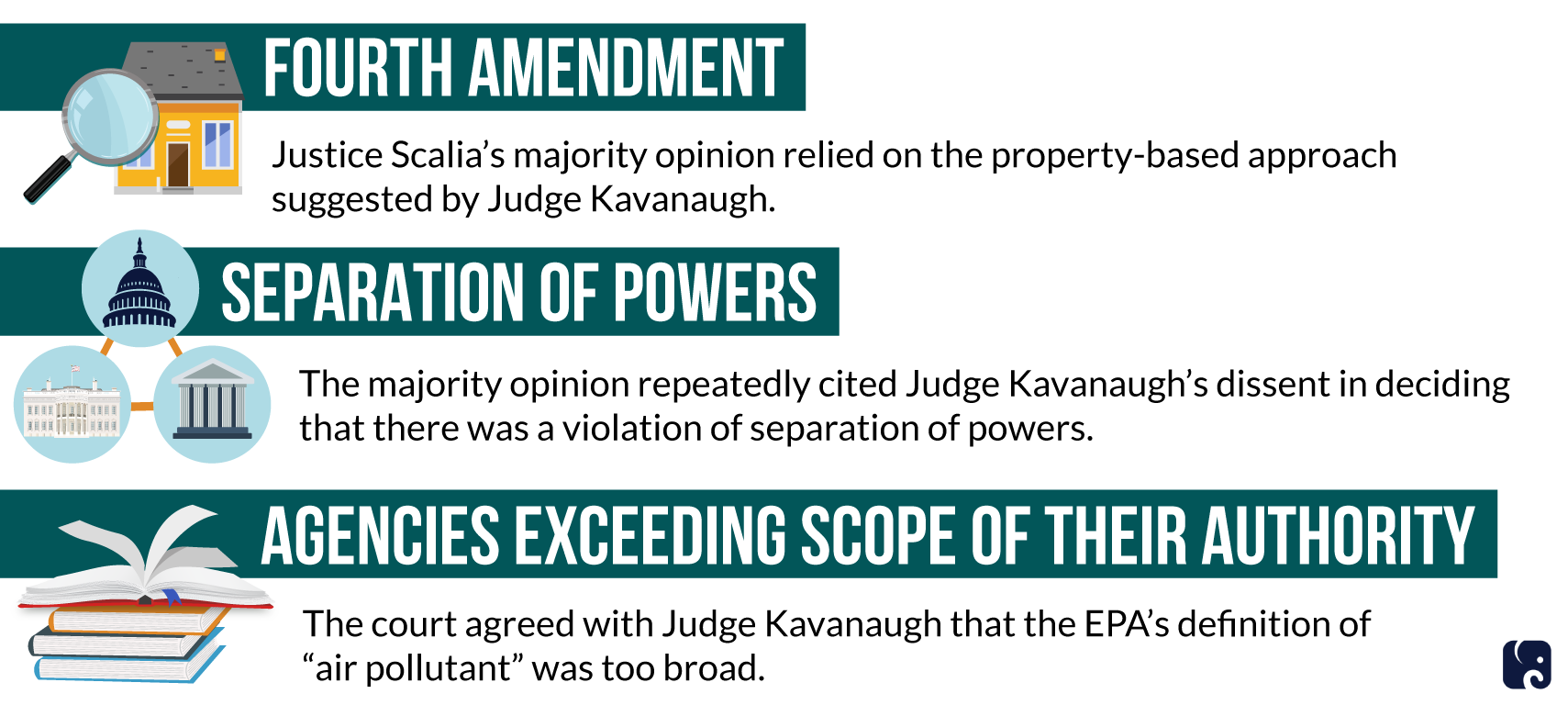SCOTUS Agrees with Kavanaugh
KEY TAKEAWAYS
- In Judge Brett Kavanaugh’s 12 years on the D.C. Circuit, he has been reversed by the Supreme Court only once, and then only partially.
- The Supreme Court has adopted Judge Kavanaugh’s reasoning in at least 13 cases, including cases on the Fourth Amendment, separation of powers, and administrative law.
- Leading legal scholars have called Judge Kavanaugh “one of the most learned judges in America” and “a true intellectual – a leading thinker.”
In 12 years on the D.C. Circuit, Judge Brett Kavanaugh has distinguished himself as an astute and independent judge and as a thought leader on the federal bench. His careful study of the Constitution, statutory text, and Supreme Court precedent has led courts around the country to rely on his opinions. His influence extends to the Supreme Court, which has adopted his reasoning in more than a dozen cases.
Kavanaugh’s Influence on the Supreme Court

As liberal constitutional scholar and Yale Law School professor Akhil Reed Amar explained, “Judge Kavanaugh commands wide and deep respect among scholars, lawyers, judges, and justices.” He noted that many of “Kavanaugh’s biggest ideas have found their way into Supreme Court opinions.” Highly cited statutory interpretation expert William Eskridge, also a professor at Yale, called Judge Kavanaugh “one of the most learned judges in America on a variety of issues, ranging from theories of statutory interpretation to separation of powers.” Professor Abbe Gluck agreed, describing Judge Kavanaugh as “a true intellectual – a leading thinker and writer on the subjects of statutory interpretation and federal courts.”
RESPECTED BY HIS PEERS AND THE SUPREME COURT
Judge Kavanaugh has an excellent record at the Supreme Court. He has written almost 200 controlling opinions. The Supreme Court has reversed him only once, and then only partially. In at least 13 cases, the Supreme Court adopted Judge Kavanaugh’s reasoning, including in the following three of his dissents.
Kavanaugh’s Reasoning Adopted by the Supreme Court

-
In a case involving whether a warrant was required to place a GPS transmitter on a suspect’s car, Judge Kavanaugh determined that the D.C. Circuit should have considered whether a Fourth Amendment search occurred when the transmitter was installed on the car. In dissent to an order denying a rehearing, Judge Kavanaugh said that the court should have taken the suspect’s property rights into account when it considered whether the Fourth Amendment permitted installation of the device without a warrant. On appeal to the Supreme Court, Justice Antonin Scalia’s majority opinion relied on this property-based approach to determine that a Fourth Amendment search did occur.
-
In another case, the Supreme Court considered whether the method for appointing and removing members of the Public Company Accounting Oversight Board violated the Appointment Clause and separation of powers doctrine. The statute provided that the members were appointed, and could be removed for cause, by the Securities and Exchange Commission. Two members of the D.C. Circuit panel held that the board’s structure was constitutional. Judge Kavanaugh, however, dissented, looking to the text and original meaning of the Constitution and determining that the board’s structure violated the separation of powers principle. He noted that the “Framers of our Constitution took great care to ensure that power in our system was separated into three Branches, not concentrated in the Legislative Branch; that there were checks and balances among the three Branches; and that one individual would be ultimately responsible and accountable for the exercise of executive power.” While the board was designed to be outside of presidential control, Judge Kavanaugh cautioned that our “constitutional structure is premised ... on the notion that such unaccountable power is inconsistent with individual liberty.” The majority opinion for the Supreme Court cited Judge Kavanaugh’s dissent repeatedly in holding the board’s structure unconstitutional.
-
In another dissent from a denial of rehearing, Judge Kavanaugh concluded that the EPA exceeded its statutory authority in writing greenhouse gas emissions rules that defined “air pollutant” too broadly. “As a court,” he wrote, “it is not our job to make the policy choices and set the statutory boundaries, but it is emphatically our job to carefully but firmly enforce the statutory boundaries.” The Supreme Court vindicated Judge Kavanaugh’s reasoning, agreeing that the EPA’s definition of “air pollutant” was too expansive.
Next Article Previous Article
